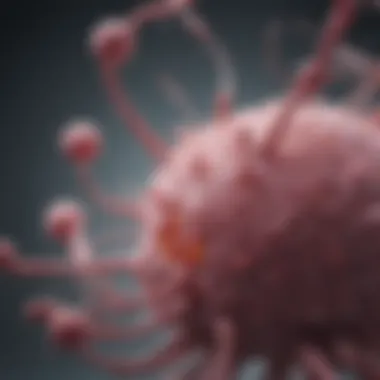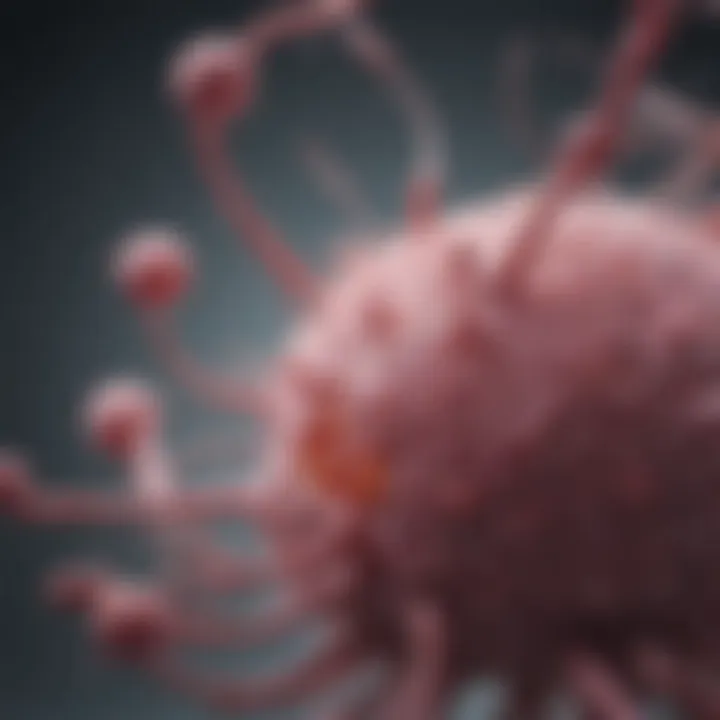Valter Longo's Chemotherapy and Fasting Insights


Intro
Valter Longo has carved a distinct niche in the realms of longevity research and cancer therapy, interweaving fasting with chemotherapy in a way that challenges traditional paradigms. His approach hinges on an intriguing thesis: that fasting, when integrated appropriately with cancer treatment, can significantly bolster the efficacy of chemotherapy while mitigating its side effects. This article embarks on an exploration of his research findings and the broader implications these have for cancer care.
Fasting—simply put—entails abstaining from food or caloric intake for a specified period. This age-old practice, often seen in various cultures and religions, has garnered new interest in medical science, especially in oncology. Longo's research draws from diverse fields, including biology, biochemistry, and clinical studies, paving the way for a nuanced understanding of how fasting could enhance conventional cancer treatments.
In the following sections, we will delve into the key findings of Longo's studies while considering background knowledge necessary to comprehend their significance. Furthermore, a closer examination of the methods utilized in his experiments will clarify how fasting interacts with chemotherapy at the cellular level, potentially leading to improved patient outcomes.
Ultimately, the intention is to present a comprehensive narrative that not only informs medical professionals and researchers but also enriches the understanding of laypersons seeking knowledge about this innovative approach to cancer treatment.
Prolusion to Valter Longo's Research
Valter Longo stands at the intersection of cellular biology and oncology, challenging traditional notions of cancer treatment through his innovative ideas on fasting and its implications for chemotherapy. In the sphere of cancer care, patients often grapple with the arduous side effects that accompany chemotherapy, which can sometimes be worse than the disease itself. Longo's research endeavors to explore how fasting might serve not just as an adjunct but as a transformative approach to enhance the efficacy of these treatments.
Fasting may appear simply as the act of abstaining from food, yet its physiological ramifications are complex and profound. Longo's work reveals how this ancient practice can trigger biological responses that potentially mitigate the toxicity of chemotherapy while possibly increasing its effectiveness. This dual action is of paramount importance, especially in a landscape where patient outcomes are paramount.
One of the salient features of Valter Longo's research is his emphasis on the Fasting-Mimicking Diet. Unlike traditional fasting, which might not be feasible for every patient undergoing treatment, Longo's diet aims to replicate the benefits of fasting while still allowing for some caloric intake. This approach retains nutritional flexibility, which is crucial in the patient population where nutritional needs can vary dramatically.
Moreover, Longo’s protocols are not merely theoretical; they rest on a bedrock of empirical evidence. Through meticulous studies involving both animal models and human clinical trials, Longo has documented tangible improvements in how cancer therapies can be administered alongside fasting strategies. As we delve deeper into his findings, it is essential to recognize that the implications extend far beyond personal health and touch upon broader oncological practices.
As we proceed through this exploration, it will become evident how Longo's insights challenge the status quo surrounding chemotherapy.
"Fasting is not about depriving yourself; it's about enhancing what your body can achieve."
This perspective is crucial for understanding the potential of integrating fasting into the continuum of cancer care. It serves as a lens through which both healthcare professionals and patients can rethink the relationship between diet, treatment resilience, and health outcomes.
By examining these concepts closely, we aim to foster a nuanced dialogue on Longo's contributions to oncology and uncover fresh possibilities for future research and clinical practice.
The Science of Fasting
The topic of fasting holds significant weight in the discourse surrounding health and treatment strategies, particularly when exploring its synergistic effects with chemotherapy in the landscape of cancer treatment. Valter Longo's research notably elevates this conversation, highlighting how structured fasting can not only enhance the effects of chemotherapy but may also mitigate some of its harsher side effects. Understanding the science behind fasting is pivotal, as it navigates various methodologies and physiological responses that can lead to improved patient outcomes.
Types of Fasting
Fasting is not a one-size-fits-all endeavor; it offers different approaches that cater to varying health needs and personal preferences.
Intermittent Fasting
Intermittent fasting is perhaps the most recognized form among the different fasting types. It involves cycling between periods of eating and fasting. The crux of this method is that it allows individuals to consume meals within a specific window—often 8 hours a day, followed by a 16-hour fasting period. This practice doesn't just simplify meal timing; it also encourages the body to switch its energy source from glucose to fat, which can be incredibly beneficial during cancer treatment.
The key characteristic of intermittent fasting lies in its simplicity and adaptability. Many find it an easier option to incorporate into their lives compared to more stringent fasting methods. A unique advantage is that it can be maintained long-term without the extreme restrictions that sometimes make other diets untenable, which is crucial for patients undergoing chemotherapy.
However, some might find it challenging initially, particularly in adjusting to longer fasting periods without food.
Extended Fasting
Extended fasting, generally more intense than intermittent, involves refraining from all food intake for 24 hours or longer. This type of fasting can have profound biological impacts, including a significant reduction in growth factors such as insulin-like growth factor 1 (IGF-1), which is often associated with cancer progression.
A standout feature of extended fasting is its ability to foster a deep state of autophagy, a cellular process that removes damaged components, thus potentially improving cellular health. While this form of fasting can be beneficial, it’s not without its drawbacks. Patients often experience more significant fatigue and potential nutrient deficiencies, highlighting the necessity of proper supervision during such fasting periods.
Time-Restricted Eating
Time-restricted eating is a more flexible approach that limits the time span during which one consumes food. Commonly, individuals may choose to eat within a 10-hour window or less.


The key characteristic of this method is its emphasis on when to eat rather than what to eat. Research suggests that having defined eating windows can synchronize metabolic processes with circadian rhythms, potentially improving insulin sensitivity. This can be particularly helpful for cancer patients looking to manage blood sugar levels while undergoing chemotherapy.
Despite its benefits, some may struggle with social eating situations that fall outside of their designated time frames.
Physiological Effects on the Body
Understanding how fasting influences our physiology deepens the insights into why it could be advantageous for cancer patients undergoing chemotherapy.
Metabolic Shifts
Fasting induces notable metabolic shifts, significantly affecting energy utilization. These shifts promote fat oxidation and harness ketone bodies as an alternative energy source. The key feature of these shifts is their ability to enhance metabolic flexibility, allowing the body to adapt effectively to limited energy availability. Such adaptations can be particularly relevant during treatments that challenge patients' energy levels.
One advantage in the context of this article is how these shifts could make cancer cells more vulnerable to chemotherapy while protecting healthy cells from the toxicity of treatment.
Hormonal Regulation
Another critical aspect of fasting is its role in hormonal regulation, especially concerning insulin and cortisol. Fasting periods help lower insulin levels, which can subsequently reduce growth signals that tumors often thrive on. This becomes a significant talking point when considering the overall goals in cancer therapy.
In addition, regulated cortisol buildup through fasting may help manage stress responses, supporting overall patient well-being during treatment.
Cellular Stress Response
Cellular stress responses activated through fasting may offer substantial benefits as well. These responses can promote resilience in cells, preparing them to face the challenges imposed by chemotherapy. Fasting may induce a mild stress state that can help normal cells bolster their defenses against extreme stress from anticancer drugs.
The unique feature here is that while cancer cells often struggle under these conditions, healthy cells can thrive, offering a dual benefit—therapeutically attacking tumors while safeguarding surrounding, noncancerous cells.
Fasting in the Context of Cancer
The discussion around fasting in the context of cancer is a landscape rich with insights and implications. It offers a refreshing perspective on how traditional treatments, like chemotherapy, might be enhanced through dietary strategies. Valter Longo’s work shines light on this intersection, proposing that fasting can synergistically augment the effects of chemotherapy while mitigating some harsh side effects that many patients endure during treatment.
Understanding the nuances of this topic helps comprehend the biological mechanics, emotional toll, and the metabolic adaptations involved in cancer treatment. The key idea here is to explore how fasting alters physiological processes in a way that can potentially lead to better outcomes for patients battling malignancies.
Mechanisms of Action
Autophagy
Autophagy stands out as a critical mechanism in the context of fasting during chemotherapy. Simply put, it involves the body’s way of clearing out damaged cells and regenerating healthy ones. In the backdrop of cancer, where cellular abnormities thrive, boosting autophagy can be tantamount to hitting the reset button on cellular health.
This self-cleaning process is not just beneficial; it's vital. By rejuvenating cells, autophagy offers a protective effect, particularly when subjected to the toxic environment of chemotherapy. Cells can better withstand treatment, and healthier cells may emerge to replace damaged ones. However, while autophagy is generally viewed positively, one should be cautious. Overactive autophagy, in certain contexts, can support cancer cell survival, presenting a double-edged sword.
Apoptosis
Next up is apoptosis, the body’s intrinsic mechanism for programmed cell death. When fasting is introduced, the body can amplify signals that promote apoptosis, particularly in cancer cells. Essentially, this programmed death can target malignant cells while sparing normal tissues, making chemotherapy more effective.
A key characteristic of apoptosis is that it encourages a clean break—it doesn’t just suppress cell growth; it eliminates potentially malignant cells altogether. It makes perfect sense therefore to consider this a particularly advantageous aspect in the immunological fight against cancer. Nevertheless, while enhancing apoptosis can be a boon, the complexity of cellular processes means that careful monitoring is required to avoid negative outcomes for surrounding healthy tissues.
Inflammation Modulation
Fasting also plays a role in inflammation modulation, a significant concern in cancer treatment. Chronic inflammation can cloud the effectiveness of chemotherapy. Therefore, honing in on how fasting can temper this response is essential.
By reducing systemic inflammation, fasting may help create a more favorable environment for chemotherapy to work its magic. A vital aspect here is that prolonged inflammation can lead to cellular mutation, feeding into the cancer growth cycle. Thus, calmer, more balanced inflammation levels can foster the body’s natural defenses, ultimately aiding recovery. However, one must also consider the balance. Excessive fasting or inappropriate application might have adverse effects that could exacerbate inflammation in specific cases.
Empirical Evidence
Animal Studies


Turning our attention to empirical evidence, animal studies have long served as a cornerstone in understanding the complexities of fasting and cancer treatment. These studies often illuminate how specific fasting regimens affect tumor growth and treatment outcomes in controlled environments.
One of the notable characteristics of animal studies is their ability to reveal intricate biological pathways that may remain hidden in human trials initially. For instance, certain rodents subjected to fasting during chemotherapy exhibited significant reductions in tumor size compared to those that received treatment alone. The conundrum, however, is translating animal findings to human applications without oversimplifying or disregarding human biological variability and complexity.
Human Clinical Trials
Hierarchically, human clinical trials represent the pinnacle of research validation. This is where fasting protocols are tested to affirm their efficacy and safety during chemotherapy in actual patients. These trials make use of longitudinal insights and patient outcomes to draw conclusions that can influence clinical practice.
A notable characteristic here is the vast variability in human responses to fasting and chemotherapy combinations. Some individuals flourish under a fasting-mimicking diet during treatment, showing improved resilience and less severe side effects. Conversely, others might struggle significantly, underscoring the importance of personalization in cancer treatment strategies. As such, employing a flexible approach in human trials can lead to richer data that can inform better health outcomes and protocols.
In essence, exploring fasting in the cancer context, informed by both mechanisms and empirical evidence, opens the door to innovative treatment possibilities. Understanding the science leads us toward a future where chemotherapy can be complemented by dietary strategies, leaving no stone unturned in the quest for optimal patient outcomes.
Longo's Protocol for Fasting During Chemotherapy
In the realm of modern oncological therapies, Valter Longo's protocol for fasting during chemotherapy emerges as a significant topic. It suggests that fasting, when strategically timed, can tailor the body's response to chemotherapy, amplifying its effectiveness while simultaneously minimizing its adverse effects. Understanding this protocol can reshape the way healthcare professionals approach cancer treatment, offering a blend of traditional methods and innovative strategies.
Fasting-Mimicking Diet
The Fasting-Mimicking Diet, often termed FMD, is a cornerstone of Longo's approach. Unlike traditional fasting that is sometimes impractical in a clinical context, FMD allows for a carefully structured intake of specific nutrients designed to mimic the physiological effects of fasting. Participants consume a low-caloric, plant-based diet that is rich in healthy fats, proteins with low amino acid content, and carbohydrates from whole foods. This careful balance is intended to trigger favorable metabolic pathways without the stress of complete food abstinence.
Research suggests that patients on the FMD experience a reduction in the cancers’ resistance to chemotherapy, effectively paving the way for more potent treatments. By prohibiting high levels of proteins while providing essential nutrients, this diet fosters autophagy - a cellular cleaning mechanism that helps eliminate dysfunctional cells, thus potentially heightening the cancer-fighting capabilities of chemotherapy.
"Fasting can act as the ‘reset’ button for the body�’s cells, gearing them up to face the onslaught of chemotherapy more resiliently."
Implementation in Clinical Settings
Implementing Longo's fasting protocol into clinical settings involves multiple layers of consideration. First, it is paramount to conduct thorough assessments of patients' overall health, considering factors like their cancer stage, treatment regimen, and nutritional status. This tailored approach ensures that while the patients reap the benefits of fasting, it doesn't adversely affect their general wellbeing.
In practice, oncologists can incorporate FMD before, during, and after chemotherapy cycles. For instance, some studies have shown that following the FMD for a few days prior to chemotherapy can enhance the drug’s efficacy while concurrently mitigating potential side effects such as nausea and fatigue. Moreover, healthcare teams often provide resources and guidance, ensuring that patients understand how to follow the diet correctly and safely.
The integration of Longo's protocol in the daily clinical workflow also emphasizes the role of interdisciplinary collaboration. Dietitians and oncologists need to work hand-in-hand, creating a cohesive treatment strategy that serves the therapeutic needs and preferences of the patient. As the field evolves, continuous monitoring and feedback will be critical in optimizing fasting regimens for diverse patient populations.
Potential Benefits of Fasting with Chemotherapy
The intersection of fasting and chemotherapy presents a promising avenue for enhancing cancer treatment effectiveness. Valter Longo’s research suggests that fasting may potentiate the benefits of chemotherapy, making it a notable topic in the ongoing dialogue about cancer care. By marrying traditional treatments with fasting strategies, we open a door to improved outcomes and patient experiences. Here, we break down two major aspects that warrant attention: enhanced treatment efficacy and the potential reduction of adverse side effects.
Enhanced Efficacy of Treatment
Valter Longo’s work posits that fasting can prime the body to respond more efficiently to chemotherapy. The concept revolves around how fasting affects cellular processes that are crucial during treatment. When the body is in a fasting state, it enters a phase of cellular conservation and stress resistance. Under these conditions, cancer cells may become more vulnerable to chemotherapy agents due to their altered metabolic states.
- Cellular Vulnerability: Cancer cells often rely on rapid growth and division, which fasting disrupts. This disruption can lower their energy reserves, making them less capable of surviving the toxic effects of chemotherapy drugs.
- Synergistic Effects: Longo's research has indicated that fasting can induce autophagy—where cells recycle their components. This mechanism, when coupled with chemotherapy, may enhance the cancer-fighting effects of the drug by ensuring that only the healthiest cells survive, while the damaged ones undergo programmed cell death.
- Biomarker Regulation: Fasting influences the body’s levels of specific biomarkers crucial in determining drug efficacy. For instance, it can decrease insulin levels and alter growth factor signaling, which in turn could enhance the sensitivity of cancer cells to treatment.
Reduction of Side Effects
Another compelling advantage of incorporating fasting into chemotherapy regimens is the potential for mitigating side effects—a significant concern for patients undergoing cancer treatment. Many chemotherapy drugs carry a heavy toll on the body, often leading to severe and debilitating side effects like nausea, fatigue, and immune suppression. Fasting may alleviate some of these burdens.
- Metabolic Protection: Fasting helps in maintaining metabolic balance during chemotherapy. Research indicates that patients who fast or adhere to a fasting-mimicking diet reported fewer instances of nausea and other gastrointestinal side effects.
- Immune System Support: Chemotherapy can suppress the immune system, making patients highly vulnerable to infections. The immune-boosting properties exhibited during fasting—such as the renewal of immune cells—could counterbalance this risk. This helps patients bounce back quicker from treatment, potentially reducing hospital visits due to complications.
- Overall Well-being: Beyond physical side effects, fasting may positively affect the psychological state of patients. Many individuals have reported feeling a stronger sense of control and empowerment when engaging in fasting practices while managing their treatment protocols.
Fasting and chemotherapy together offer not just hope for enhanced outcomes but a holistic improvement in patient quality of life.
In summary, embracing fasting in the context of chemotherapy is an avenue rife with potential benefits. The dual focus on treatment efficacy and side effect reduction illustrates why it's a topic worthy of further exploration. Longo's insights illuminate a pathway for better therapeutic outcomes, offering a beacon of hope to those navigating the fraught waters of cancer treatment.
Challenges and Considerations
In the realm of chemotherapy coupled with fasting—specifically Valter Longo's approach—there are multifaceted challenges and considerations that warrant careful examination. This interplay between dietary practices and cancer treatment is anything but straightforward. Navigating the complexities involves understanding patient selection, nutritional concerns, and ethical considerations, all of which play significant roles in optimizing treatment outcomes while safeguarding patient well-being.


Patient Selection
Effective patient selection is paramount when implementing fasting protocols alongside chemotherapy. Not every cancer patient may benefit equally from fasting, and some could potentially be harmed by it.
Here are some key factors to consider:
- Cancer Type: Certain cancers have different metabolic profiles. For instance, patients with aggressive forms of cancer may experience varied reactions to fasting, compared to those with less aggressive diseases.
- Stage of Disease: The urgency of treatment can greatly influence whether fasting is appropriate. Patients undergoing significant treatments may need to prioritize immediate nutritional support rather than risk fasting’s potential downsides.
- General Health Status: We should account for the overall health of the patient, including pre-existing conditions like diabetes or cardiovascular issues, which might complicate fasting practices.
Ultimately, the selection process should involve a thorough assessment by oncologists and dietitians in collaboration with patients. Careful deliberation can ensure that fasting is beneficial rather than detrimental.
Nutritional Concerns
When fasting is proposed as an adjunct to chemotherapy, addressing nutritional concerns becomes vital. Avoiding malnutrition is critical for preserving quality of life during challenging treatments. Nutrition must be tailored to a patient’s unique needs before, during, and after chemotherapy, especially with fasting considerations in play.
Here are points to ponder:
- Micronutrient Sufficiency: Fasting should not lead to deficiencies of essential vitamins and minerals. Ensuring adequate intake of nutrients like vitamin D, magnesium, and omega-3 fatty acids can impact recovery positively.
- Hunger Management: Fasting may heighten discomfort for some individuals. Strategies to manage hunger, including hydration and possible gradual adaptation to fasting, can alleviate feelings of deprivation.
- Balanced Diet Post-Fast: After fasting periods, reintroducing food should be approached mindfully to prevent digestive distress. A well-balanced diet filled with antioxidants and anti-inflammatory foods can play a beneficial role in cancer recovery.
Ethical Implications
Integrating fasting into chemotherapy raises significant ethical questions that necessitate serious contemplation. The core of these considerations revolves around patient autonomy, informed consent, and the obligation of care professionals to prioritize patient safety over experimental initiatives.
Questions to ask include:
- Autonomy vs. Evidence: Should patients have the right to choose fasting despite a lack of extensive research proving its efficacy? Patients must be fully informed of the potential risks and benefits to make empowered decisions.
- Risk of Potential Harm: How do healthcare professionals balance between exploring innovative treatments like fasting and the potential risks they may impose on patients? Conducting fasts during treatment should not be viewed lightly, as it can affect treatment efficacy and patient health.
- Clinical Trial Frameworks: It becomes essential to construct ethical frameworks for clinical trials studying fasting alongside chemotherapy. Regulations must ensure that participants are fully informed while maintaining safety protocols.
In sum, while the promise of combining fasting with chemotherapy is tantalizing, the necessity for clarity around challenges and considerations cannot be overstated. Through critical thinking, careful assessment, and respectful dialogues between practitioners and patients, the integration of fasting into cancer care can transition from theory to practice effectively.
Future Directions for Research
In the realm of chemotherapy and fasting, Valter Longo's insights have sparked a plethora of discussions and inquiries into how these two elements can interplay to optimize oncological outcomes. The journey doesn’t end here; in fact, it marks just the beginning of what could be a revolutionary path in cancer treatment protocols. This section delves into innovative study designs and longitudinal impact assessments that can push forward the boundaries of this research.
Innovative Study Designs
When considering future strategies for uncovering the potential benefits of fasting during chemotherapy, it's crucial to think outside the box. Traditional study models often focus narrowly on either chemotherapy or fasting in isolation. A more integrative approach could yield richer data. For instance, randomized controlled trials that juxtapose standard chemotherapy protocols with variations of fasting—such as intermittent fasting versus a fasting-mimicking diet—might provides deeper insights into differential responses in patients.
Additionally, utilizing multi-center collaborations could help gather a more diverse patient demographic. This broad approach is important as it allows researchers to assess varying responses based on age, genetic background, and existing health conditions. With the rise of technology, incorporating wearable fitness devices could help monitor patients’ physiological responses in real time, letting researchers tie fasting effects to specific biological changes more accurately.
"Innovative study designs not only magnify the effectiveness of our understanding but also draw a clearer roadmap for future clinical applications."
Longitudinal Impact Assessments
Equally paramount to innovative study designs are longitudinal impact assessments. Tracking patients over longer periods can reveal the sustained effects of fasting in cancer care. Such assessments could look beyond immediate outcomes, focusing on quality of life, recurrence rates, and even survivorship metrics. These long-term studies may uncover vital data on how fasting during treatment influences remission durations.
Consideration of psychosocial factors is also essential in longitudinal assessments. Cancer treatment is notoriously taxing on patients, and the integration of fasting could affect emotional and psychological states. Assessing parameters such as fatigue, mental clarity, and overall well-being can help paint a fuller picture of fasting’s role in treatment.
An example of this might be a study that evaluates patients over five years post-treatment, analyzing their dietary habits, fasting practices, and corresponding health outcomes. This could provide invaluable insights not just into medical outcomes but also into lifestyle adaptations that promote long-term health.
Epilogue
The intersection of fasting and chemotherapy, particularly through the lens of Valter Longo's research, reveals important implications for cancer treatment protocols. This article emphasizes several key elements surrounding this innovative approach.
Summary of Findings
Fasting, especially when mimicked through carefully designed diets, demonstrates the potential to enhance chemotherapy effectiveness while mitigating the adverse side effects often associated with traditional cancer treatments. Research indicates that mechanisms such as autophagy and inflammatory modulation play a crucial role in these benefits. Through his innovative fasting-mimicking diet, Longo has provided a framework that can harmonize the rigors of chemo with nutritional strategies aimed at improving patient outcomes. Studies, both in animals and humans, back his propositions, suggesting that fasting could be integrated into clinical oncology more widely in the future.
Final Thoughts on Fasting and Chemotherapy
While there are many potential benefits to integrating fasting into chemotherapy treatment, the road ahead is fraught with considerations. Patient selection is critical; not every individual may respond similarly due to health differences or cancer types. Nutritional concerns must be balanced with treatment goals to ensure that patients receive adequate nutrition during these challenging times. Moreover, the ethical implications of altering standard chemotherapy protocols warrant a thoughtful discussion among medical professionals. In essence, the dialogue surrounding fasting in cancer care is just beginning, but the signs indicate a promising avenue for enhancing treatment effectiveness and patient comfort. The collaboration between oncologists and nutritionists could very well spearhead a paradigm shift in cancer care, emphasizing a holistic approach to healing.
"Understanding how our bodies respond to fasting during chemotherapy could reshape how we fight cancer and help redefine the journey to health."







